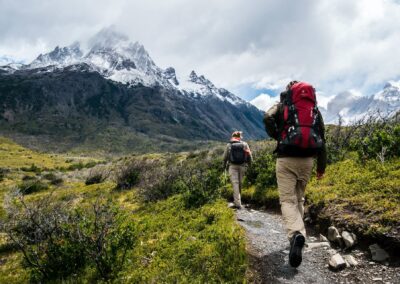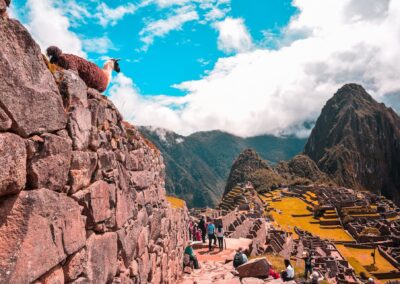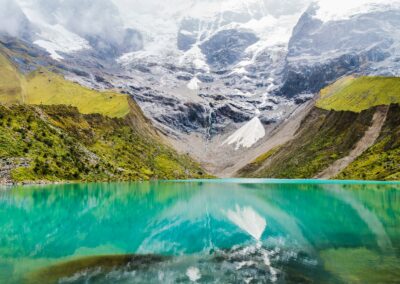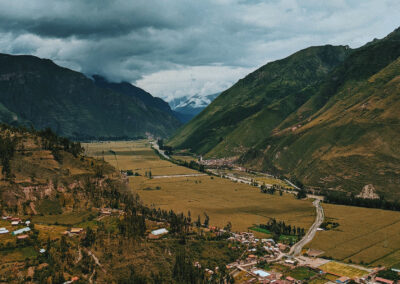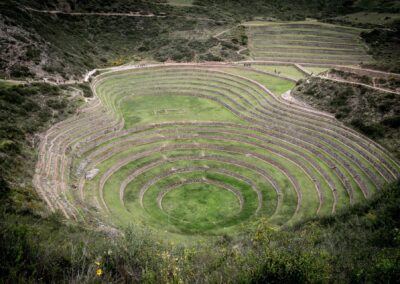Adventure in Cusco and Classic Inca Trail
8 Days / 7 Nights
ACTIVITIES
Hike, Camping, Zipline
DURATION
8 Days / 7 Nights
TIPO
Adventure / Hike
LOCATION
Sacred Valley, Machu Picchu, Cuzco
Introduction
The Adventure in Cusco and the Classic Inca Trail 8 days and 7 nights is a new proposal to be able to mix two of the best experiences in the city of Cusco, the walk and the adventure.
This experience is intended for all people who have an adequate and optimal state of health in the face of the necessary requirement, you can do it individually to be able to meet new people, as a couple or with friends with whom to share emotions and also as a family to live a unforgettable adventure.
Get inspired for your next vacation with testimonials from traveling customers like you!
Why book this tour?
Experience the adrenaline of the Via Ferrata and the Zipline.
Get to know the hotel suspended on the edge of the mountain, the Sky Lodge.
Enjoy the flavors of Peruvian gastronomy in the Sacred Valley.
Surprise yourself with the circular terraces of Moray.
Complete and overcome the challenging Inca Trail.
Overcome your limits and reach the top of the famous Gringo Killer.
Enjoy the splendid sunrise at Puerta del Sol.
Tour the beautiful Inca citadel and surroundings.
Capture the best shots from the House of the Guardian.
Discover the mystery about the Intihuatana.
Fall in love with the Inca culture with its living history.
Summary Itinerary
Day 01: Welcome to the city and transfer to your Hotel
- (At agreed time) Arrival in the city and transfer to your hotel in Urubamba
- Hotel night in Urubamba
Day 02: Via Ferrata + Zip Line
- 09:00 – 09:30 Pick up from your hotel and transfer to the Pachar sector.
- 09:30 – 13:30 We will have a short emotional talk with an instructor who will give us the guidelines and advice that we must follow to carry out both activities, after putting on the safety equipment we will begin with the ascent of 400 meters with the help of metal steps, and a line of life that will allow you to be 100% safe. The approximately one-hour ascent will take you to a suspension bridge, and to enjoy a delicious box lunch in the condors' nest, the highest part of the circuit. The mountain will be descended through 6 lines that measure between 700 meters and 250 meters, the shortest.
- 14:00 – 15:30 We will return in our transport to Urubamba where we will have a delicious lunch with typical dishes of the region and then the afternoon free at our hotel to enjoy the wonderful Sacred Valley.
- Hotel night in Urubamba
Day 03: Maras Moray by Bicycle
- 09:00 – 10:00 Pick up from your hotel in Cusco in our transport and we start the trip towards Chinchero.
- 10:00 – 13:00 From here we cycle in the direction of Lake Huaypo, before discovering the agricultural site of Moray, the colonial town of Maras and then the salt mines of Maras, where we will see the process of collecting salt, a precious mineral during the Inca border. and then at the time of the Colony.
- 13:00 – 17:00 Later we will complete our circuit by a beautiful descent to the town of Urubamba, in the lower part of the valley, next to the sacred river of Vilcanota where our mobility will wait for us to return to Cusco in the afternoon.
- Hotel night in Cusco
Day 04: Cusco – Km 82 – Wayllabamba (Inca Trail)
- 07:00 Pick up and start of the tour from your hotel in Cusco.
- Travel in private transport to the starting point and control of the Inca Trail.
- Lunch in Miskay.
- Start of the walk passing through the archaeological group of Patallacta and finally arriving at Wayllabamba (camping place).
- Total Walking Time 5 – 6 hours (12 km.) – Initial Altitude 2,750 m – Final 2,954 m.
- Overnight at the camp in Wayllabamba (Altitude: 2,954 m)
Day 05: Wayllabamba – Pacaymayo (Inca Trail)
- Breakfast in camp.
- Start of the walk passing through the Warmiwañusca pass.
- Lunch and establishment of camps in Pacaymayo.
- Total Walking Time 8 hrs (16 km.) – Initial Altitude 3,000 m – Final 3,800 m.
- Overnight at the camp in Pacaymayo (Altitude: 2,650 m)
Day 06: Pacaymayo – Wiñaywayna (Inca Trail)
- Breakfast in camp.
- Start of the walk passing through the archaeological site of Runkurakay (place of rest).
- Visit of the archaeological complex of Sayacmarca (archaeological complex).
- Lunch instead of rest.
- Walk until you reach the Wiñaywayna campsite.
- Total Walking Time 8 hrs (16 km.) – Initial Altitude 3,800 m – Final 2,650 m.
- Overnight at the camp in Wiñaywayna. (Altitude: 2,650m)
Day 07: Wiñaywayna – Machu Picchu – Cusco (Inca Trail)
- Breakfast in camp.
- Start of the walk until you reach the Puerta del Sol or Inti Punku.
- Guided tour in the Inca Citadel of Machu Picchu.
- Descent towards the town of Aguas Calientes.
- Lunch and free time in Aguas Calientes.
- 16:22 Return by train to Ollantaytambo.
- Transfer from Ollantaytambo to your hotel in Cusco.
- Total Walking Time 2 hrs (4 km) – Initial Altitude 2,650 m – Final 2,400 m.
- Approximate time of arrival in Cusco 20:00.
- Hotel night in Cusco
Day 08: Day of your departure
- (At agreed time) Transfer from your hotel to the airport (2 hours before your flight).
Detailed Itinerary
Our experience allows us to know the main places in the city of Cusco, enjoying the comfort in each space and the necessary security, the places that we will know are:
- Maras: The town of Maras was founded by the Spanish in the year 1556, its importance during the viceroyalty stood out (it was the main supplier of salt in the Andes), as evidenced by its church dedicated to San Francisco de Asís and the mansions that still preserve the almost intact shields belonging to each family of the indigenous nobility on their facades, even with the passage of time you can read the date inscribed on which they were built on many of them. The Salinas de Maras on the other hand has an older history belonging to the Inca period, they are located on the slope of the hill, these are shaped like pools that are crossed by a small stream that provides salt water to each one. The use of the Salt of Maras is varied since it is now commercialized and can be used in medicinal baths, personal consumption and others. Its collection process is passed from generation to generation, but it is managed in a communal way where all the inhabitants participate.
- Moray: A particular Archaeological complex that today still causes great curiosity when visited due to the shape of the design it has. They are circular terraces that simulate in some way the Amphitheater that we find in the Roman culture, according to the investigations that were made since the 90s, this place fulfilled the function of adapting the seeds of the various products in the different altitudinal floors that the Valley has. Sacred, this allowed for a great variety of products in each place and at the same time gave the possibility of new varieties. With the use of spectral thermometers, it was also determined that each circular terrace has a different temperature, which allows adaptation to be more efficient since the climate in the entire region is always changing.
- Llactapata: Its name, coming from Quechua words, mentions a city in the heights due to its location on top of a mountain, even for Hiram Bingham in his 1912 expedition, it was complex to find this place due to the inaccessibility due to the vegetation and the poisonous snakes. Over time after its discovery, the archaeological complex of Llactapata was once again covered by vegetation. Only in the year 2003 was it thoroughly studied by Ziegler-Thomson. It is concluded that Llactapata was a very important place near the Inca Trail that leads to Machu Picchu. In the extreme north we can find the archaeological complex of Patallacta, many of the researchers conclude that its function was purely agricultural. This complex has four very different sectors due to the shape and organization of the buildings.
- Warmiwañusca: It is the highest point of the whole experience. To get here you need a walk of 4 or 5 hours, on a steep path. The panorama that we observe is full of ichu or straw and mountains with abundant flora, in the distance we can also see some popular snow-capped mountains in the area. The name of this place means Dead Woman since at the top of the pass we can see the silhouette of a woman in the surrounding mountains, at this point the air is a bit dense and cold, since the air she breathes is icy the previously mentioned snow-capped mountains. Here we have a beautiful view from both sides with an impressive panorama, because you can see part of the jungle, the snow-capped mountains, one feels closer to heaven than to earth.
- Runkurakay: It is an archaeological complex with a semicircular shape, with a central plaza and buildings that surround the construction; in the walls you can find niches and trapezoidal doors.
- One has the idea that probably due to the strategic site in which it is located, its function has been that of a Tambo or surveillance site. But the form it has still leaves much to be said, it is likely that over time its real function has been different. The dense vegetation found around this place is due to the abundant flora of the jungle.
- Sayaqmarka: It bears the name in Quechua that translated means the town on foot, this was granted in the year 1941. In its buildings we can find narrow streets, precincts and arranged passages, squares, canals, walls with niches and trapezoidal doors. All built on inhospitable terrain, where they had to overcome the laws of gravity. The base is elongated and there is only one way to get in and out. We also find a large staircase with countless steps, leading to a main square. The archaeological center is surrounded by terraces with abundant vegetation. The construction is based on the style of the Imperial era of the Inca culture, due to the location it is believed that it could have been a control site and logically the people who lived in that place had their houses, warehouses, canals and a place of worship to the Sun.
- Phuyupatamarka: This wonderful place is located on top of a mountain and its particular name means City above the clouds. It is an Inca construction with a huge number of terraces, which have the function of containment and to also be used for agriculture. It contains a set of enclosures, roads, a small bridge, three squares, a sacred rock and two main entrances, we can also see irrigation canals and fountains, probably ceremonial, that still work. The most interesting thing about this particular place is that it remains surrounded by clouds typical of cloud forests. The whole complex is surrounded by abundant vegetation, typical of the jungle.
- Wiñaywayna: It is the closest place to Machupicchu and its name means Eternally Young, this archaeological center was probably built by the Inca Pachacutec. This archaeological complex corresponds to the plan of a small town, they are a group of grouped enclosures, simulating the current buildings. The possible dwellings have trapezoidal niches and doors with a single jamb. It is surrounded by terraces or platforms of different sizes, which makes you think that it fulfilled a double function of containment and at the same time of agriculture. We also found in the place a set of fountains. It is made of granite rock and from a high view it has a great similarity with the architectural layout of Machu Picchu.
- Intipunku: Also known as the Puerta del Sol, it is the point where the Inca Trail ends and where the descent to the citadel of Machupicchu begins. This, like other archaeological spaces, is surrounded by terraces and a lot of vegetation that makes its panorama spectacular. It is a set of enclosures, where we find lintels and doors. This set is accessed by steps from Wiñayhuayna worked in stone. Its walls show the presence of trapezoidal niches. It was probably a place of control, due to the location where it is located as an entrance to the citadel of Machu Picchu.
- Guardian House: This beautiful place is located in the highest area of the Inca citadel on the Agricultural Area. Its function was to control the entrance to the Inca city and review the entire agricultural and urban area. From here you can see a panoramic view of the entire citadel and the entrance to the old Inca trail. It has three walls: In the central wall we find three large windows, which allow us to easily observe the entrance to the Inca trail and the Inca bridge, the only means of communication with the outside world. We can also see how the Incas covered the enclosures with a ichu roof.
- Llacta Punku: It is the income for the urban sector, it is located limited by a deep excavation. This sector is located from the cemetery by a long staircase towards the peripheral neighborhoods, it has a system of points to hold a wooden door, in person and not as an element of restriction or security since the city can also be accessed by other roads.
- Ceremonial Plaza: It is a set of enclosures made around a quadrangular patio, you can see three polygonal walls, made with immense stone pieces assembled perfectly. The presence of three windows and two niches on each side stands out. It is considered that the function of these windows was probably purely religious, next to this we can find a different enclosure called The House of the Priest.
- Temple of the Sun (1:00 p.m. – 4:00 p.m.): This enclosure has a finely polished two-story structure: the first is semi-underground and the second features a beautiful semi-circular wall with perfect finishes, with an incline towards its interior due to what is called “Torreón”. It was used to celebrate religious ceremonies, especially during the months of June and December, special dates for the Solstices. This Tower has two trapezoidal windows, one oriented towards the most extreme point of the winter solstice that takes place on June 22 and the other oriented towards the Puerta del Sol (Intipunku) for the summer solstice that occurs on June 22. from December. In the middle of this architecture we can find a central rock, polished in the shape of an altar that was used for the ceremonies of interpretation of the path that the sun followed. It is built on a large rock, under which there is a small cave, which has been worked and covered with a thin wall, this is because it probably fulfilled the function of a mausoleum, because it has niches of a moderate size, where they placed the mallquis or mummies where they were worshipped.
- Temple of the 3 windows: This enclosure has three polygonal walls, built with enormous stone pieces perfectly assembled, highlighting 3 windows and 2 niches at each end. The function they had was religious magic and not only aesthetic. It was Hiram Bingham who carried out excavations in the front part of this temple, finding a large amount of fractured ceramics and highlighting the detail of the bases of this temple with a depth of more than three meters, here is also the possible symbolic figure of the head of a carved llama, this image is allegorical to the camelid because of the importance it had as a beast of burden, supplier of meat and clothing to the Incas.
- Main Temple: It has a finely polished structure with beautiful finishes, an enclosure framed by only three walls, each of the large pieces have been carefully crafted. The central wall has a dimension of 11 meters. Behind the Main Temple there is an enclosure whose function was probably also for religious use according to the records obtained and whose stones have no less than 32 angles, which makes its meaning quite mysterious.
- Intihuatana (07:00 a.m. – 10:00 a.m.): It bears his name in Quechua which translated means "where the sun hangs“, is an area that corresponds to one of the highest sectors of the Urban Zone. This is the most important area of Machu Picchu, at the top of this area we can find a huge sculpture made and carved with flat surfaces, a column of 66 cm. tall and with finely carved faces that complement the sculpture. The total space of the Intihuatana measures 8.60 meters and 1.76 meters high. The Intihuatana, is one of the most enigmatic objects of Machu Picchu, it is related to the sunrise and the mountains. The movement of the Sun causes projections of shadows at different times, this served to recognize and interpret them in different periods of the year.
- Sacred Rock: It is a carved stone that resembles the silhouette of a mountain. It is located next to the control point to access the Huayna Picchu Mountain, made up of two Huayrana-type environments (three-walled environment), with very high ceilings that face each other forming a small, almost square plaza. This rock has an important location, since it is on the path that leads to two very important sites such as Huayna Picchu and the Temple of the Moon.
- Water mirrors: Its name is in relation to the enclosure where they are found as well as to the constructions that are in the place. It is a wide sector, with a single access door, which is why it is attributed to be an Acllahuasi or House of Selected Women who were dedicated to spinning, cooking and preparing chicha or acja, for the privileged class. Among the possible functions attributed to this space are: - In one of its rooms, you can see two circular rock projections, which have the shape of mortars, they were probably used to grind grains or prepare dyes. - It is also given the name of 2 water mirrors, due to the fact that in the rainy season they agglomerate with water and allow us to see the reflected stars.
- Temple of the Condor (10:00 a.m. – 1:00 p.m.): It is a wide set of constructions, made taking advantage of the irregular shapes and on a cave that was notoriously used for ceremonies. The condor was an animal worshiped during Inca times and associated with the divinity of the mountains. The area is delimited by stairs and finely carved walls, its access is controlled by a double jamb door, which shows the hierarchy and the activities that took place in this area, it presents a great variety of closed and open environments with one and two levels. In the central patio it has as its main point, a carved rock, where the representation of the head and part of the body of a condor can be clearly distinguished. You can see the head, beak and eyes, as well as the necklace of white feathers of the Royal Condor, with the body projected towards the interior of the cave, which subtly joins two natural rocks. In this sector you can see the clear union of natural rocks with others worked by man, seeking to represent a tutelary deity. In the underground cave (the body of the Condor) offerings, ceramics and bone remains of camelids were found, which confirm the quality of a "ceremonial center" where offerings were made. In front of the temple of the condor enclosure we will find a 2-story structure that has two entrance doors, the second level is flush with the patio of the condor and by observation it must have served as the enclosure of the priest, in charge of the worship of the Condor. You descend to the first level by a staircase that connects to other rooms. In an environment attached to it, sectors for raising animals were found, other stairs lead to a lower platform.
- Water sources: We can see a large staircase next to which runs a system of 16 waterfalls, most of them carefully carved in polygonal blocks and surrounded by gutters made in the rock. The water comes from a spring in the heights of the Machu Picchu mountain that was channeled in Inca times. A separate channel at the top of the mountain also associates the seepage of rain from the mountain and diverts it to the main channel.
What's Included?
Included
Cusco and Maras Moray by Bicycle:
- Tourist transport: Travel by tourist transport to get to Pacha.
- Welcome transfer: It is done in private transport, from the airport to the hotel in Urubamba.
- Detailed briefing: It takes place before the start of the service (The briefing is a complete orientation, explaining everything about the tour. In addition, any questions you may have about it will be clarified).
- Small groups: We always handle an adequate amount of people, personalized shared tour style.
- First level guide: Professional tour guide specialized in Cultural tourism (English/Spanish).
- Equipment: Necessary safety elements such as gloves, helmet and specialized bicycle.
- Box Lunch: Includes a small portion of food (portion of rice, rolled chicken and vegetables), fruit, frugos, energy bar, water for your canteen and a sandwich (ham and cheese).
- Tourist transport: Travel by tourist transport to visit the towns of Maras, Moray and Urubamba.
- Entrance tickets: Partial Tourist Ticket (Moray) and entrance ticket to Maras.
- 3 star hotel in Cusco and Urubamba: 09 nights in a central hotel that has a private bathroom, hot water, comfortable rooms, Wi-Fi, luggage storage and breakfast the next day.
Zip Line and Via Ferrata:
- Tourist transport: Travel by tourist transport to get to Pachar.
- First level guide: Professional tour guide specialized in adventure tourism (English/Spanish).
- Equipment: Necessary safety elements such as harness, helmet, ropes and specialized gloves for zip line and via ferrata.
- Box Lunch: Includes a small portion of food (portion of rice, rolled chicken and vegetables), fruit, frugos, energy bar, water for your canteen and a sandwich (ham and cheese).
- Buffet lunch: It is a buffet in Urubamba, with a variety of Peruvian and local food.
Classic Inca Trail
- Transfer upon arrival: It is done in private transport, from the airport to the hotel.
- Detailed briefing: It takes place before the start of the service (The briefing is a complete orientation, explaining everything about the tour. In addition, any questions you may have about it will be clarified).
- Transfer Cusco-Km 82: Travel by private transport: from Cusco to km 82 of the old road to Machu Picchu (Piscacucho, starting point of the Classic Inca Trail).
- First level guide: Professional tour guide specialized in Cultural tourism (English/Spanish).
- Radio transmitter-receiver: Our main guide and the chef have these teams, for constant coordination in logistics, customer safety, requesting support, etc.
- Oxygen balloon: To instantly resolve any imbalance that occurs as a result of altitude.
- First aid kit: We always carry products to offer adequate first aid. On the other hand, if you are undergoing any medical treatment, do not forget to bring your medications.
- Small groups: We always handle an adequate amount of people, semi-private or private tour style.
- Comfortable tents: We offer 4-person tents for 2 passengers and 2-person tents for 1 passenger. In addition, they are all of the 4-season type, easily adaptable to climatic variations.
- Inflatable mattresses: Also suitable for all weather, waterproof and thermally insulated.
- Full dining room: Tent with chairs, tables, tablecloths, crockery, cutlery set for breakfast, lunch and dinner.
- Kitchen: Independent kitchen tent for groups of more than 5 people. Food is also stored there, with strict hygiene.
- Kitchen with Sustainability: We use biodegradable cleaning products: detergent, dishwasher. Our other products are handled in an ecologically responsible manner.
- Infusion upon awakening: Complimentary herbal tea in your tent, every morning before breakfast.
- Tea time: Also called tea time, is done before dinner, with herbal infusions, coffee, tea, rolls, butter, jam.
- Feeding: 3 breakfasts, 3 lunches, 3 dinners during the trek. Includes lunch at a restaurant in Aguas Calientes on the fourth day, after the Machu Picchu tour.
- Varied snack: Provided every day in a small cloth bag, so you can eat something during the walk. It consists of a fruit, an energy bar or a package of cookies and candies.
- Lunch and dinner: They are buffet or semi-buffet, with a variety of Peruvian and fusion food. Desserts and non-alcoholic drinks are also served.
- Varieties of diets: Vegetarian, vegan and other food are also available at the request of the tourist and at no additional cost. Please request your diet in advance, during the reservation.
- Kitchen staff: Specialist cooks and food preparation assistants, experienced and trained in health.
- Eco-friendly plastic: We have reduced the use of all types of disposable plastic to a minimum. We work with almost 100% reusable plastic or other materials that do not pollute nature.
- Porters: They are support personnel, born in Cusco, with extensive experience, duly uniformed and identified.
- Tempered water: We offer warm water every day for personal hygiene before meals.
- Small hand towels: They give you more comfort in your personal hygiene.
- Boiled water: It is available to drink, starting on the third day. For the previous days you must buy or bring in your reusable bottle.
- Entrance tickets: Both for the Inca Trail and for the visit to the citadel of Machu Picchu.
- Return bus: From the citadel of Machu Picchu to the town of Aguas Calientes, after the guided tour.
- Train ride: From Aguas Calientes to the train station in Ollantaytambo. (Expedition Service).
- Sale of snacks on board: Alcoholic and non-alcoholic drinks, sweets.
- Sanitary facilities: At the station and inside the train.
- Souvenir sale: Baby alpaca collection.
- Private transport: From the train station in Ollantaytambo to your hotel in the city of Cusco.
- Final transfer: We take you from your hotel to the airport, on the day you indicate (prior coordination with us).
It is also included at the request of the client:
- Fleece sheets: Very useful for camping nights, especially in winter.
- Bags (duffel bags): They are offered on loan.
- Waterproof poncho: Necessary throughout the season, for garúas and rains, we offer it as a loan.
- Canes: They are highly recommended for balance and energy saving. We also offer them at no additional cost.
- Canteen: To avoid the use of disposable plastic that pollutes nature, we suggest you buy one.
Not Included
-
Flights: International or domestic air travel is not included.
-
Huayna Picchu mountain ticket: Admission to this ascent hike must be reserved in advance, is subject to availability, and costs extra.
-
Foods not mentioned: These can be requested.
-
Personal expenses and Tips: How to buy handicrafts, clothes, drinks, etc. Tips are not included either, these are voluntary according to the service received.
-
Sleeping bag: It is essential that you have one, that resists up to -18°C. They are stuffed with feathers (we rent them for US$25.00).
-
Travel insurance: It is a very important requirement for your safety and protection, for example in case of a medical emergency, the costs will be much lower.
What To Bring?
Trekking Articles
Mochila (30 o 50 litros), cantimplora, trekking shoes, casaca impermeable.
Useful Elements
Pasaporte, efectivo en soles (compras adicionales).
Useful Items
Passport, Cash in soles, Camera, charging cord, Extra batteries.
Clothes
Small backpack, rain poncho (January and February – rainy season), warm clothes.
Health and Care
Sunscreen, sunglasses, insect repelent, sun hat, Small towel, Bottled water, Personal medication.

DIFFICULTY LEVEL
Agotador


